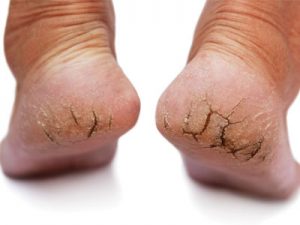Cracked heels
CONDITIONS
Cracked heels
Symptoms and Diagnosis
Very dry and cracked skin around the heel of the foot.
Causes
- Use of inappropriate footwear
- Hot, dry weather that removes moisture from exposed skin
- Diabetes with onset of autonomic neuropathy
- Lymphoma
- Thyroid problems
- Downs syndrome
- Kidney disease or use of diuretics
- Dry skin conditions such as venous stasis or contact dermatitis, eczema, and psoriasis.
Risk factors
- Genetic predisposition.
- Weight: overweight patients are at increased risk due to added pressure requiring increased elasticity in the skin.
- Pathology: patients with conditions including diabetes with onset of autonomic neuropathy, lymphoma, thyroid problems, Downs syndrome, kidney disease or use of diuretics, dry skin conditions such as venous stasis or contact dermatitis, eczema, and psoriasis.
- Inappropriate footwear: summer footwear such as thongs and flimsy sandals or rubbing straps can increase the risk for cracked heels due to rubbing, pressure and exposure of the heel to hot conditions that cause the skin to dry out.
Treatment
- Remove dead skin and wear down any calluses to leave the heels smooth. This is not recommended for patients with diabetes, end-stage kidney disease, peripheral neuropathy and/or peripheral vascular disease.
- If the skin has split, treat and dress as per standard wound care instructions.
- Strap any split skin with sports tape to prevent further splitting and to retain moisture. This is not recommended for patients with diabetes, end-stage kidney disease, peripheral neuropathy and/or peripheral vascular disease.
- Address underlying patient pathology in relation to the cracked heels and provide patient education to inform of the increased risks and contributing factors to consider when self-managing the problem at home.
- Advise the patient to avoid walking barefoot on hot surfaces and encourage the use of supportive, closed shoes that will protect the heel area and, where possible, keep the area moist while the skin dries out.
- Silicon heel cups can be inserted inside shoes to retain moisture. In elderly patients and patients with diabetes, end-stage kidney disease, peripheral neuropathy and/ or peripheral vascular disease, cracked heels can lead to pressure injuries as a result of pressure overload and the patient should be assessed accordingly.
